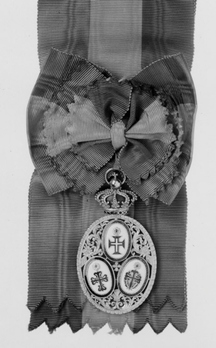Riband of the Three Orders, Grand Cross (with crown and filigree, 1862-1910)
CATEGORY: Version
SKU: 01.PRT.0110.101.01.002
Estimated market value:

Estimated market value:
The Riband of the Three Orders (A Band das Tres Ordens) is the reunion of the three ancient, religious and military Portuguese Orders of Christ, of Saint James of the Sword, and of St. Aviz. The Riband was established by Queen Mary I in 1789, following the secularization of the three Military Orders, as an effort to equalize their importance in Portugal.
Since its inception, the only grade has been the Grand Cross (BTO) which is composed of a sash and a star. During the monarchy and from 1918 to 1962, it was awarded to foreign Heads of States, but it has been worn exclusively by the President of the Portuguese Republic since 1962.
It was suspended by the republican government in 1910, and re-instituted in 1918.
The Head of State of Portugal is the Grand Master and, during the royal period, the Crown Prince was the Grand Commander; the Grand Master and Grand Commander could grant this decoration.
The Riband consists of a sash badge with three colors: violet for the Order of St. James of the Sword, green for the Order of St. Aviz, and Red for the Order pf Christ. The badge features these three insignia.
Among the recipients are Alberto I (1919) and Leopoldo III (1938) of Belgium, King Jorge VI (1939) and Queen Isabel II (1955), King Bhumibol Adulyadej (1955) of Thailand, the Brazilian Presidents Café Filho (1955) e Kubitschek de Oliveira (1957), and General Francisco Franco (1962).
There are several versions that differ in size, orientation of the crosses, design, and suspension. Also, there are additional versions that include those composed of precious stones.

Comments
Sign in to comment and reply.


Scroll Top